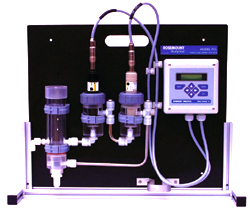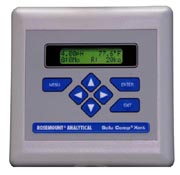
|
Model MCL Monochloramine Measuring System
- COMPLETE SYSTEM INCLUDES sensor, connecting cable, analyzer, and flow controller.
- VARIOPOL QUICK-DISCONNECT FITTINGS make replacing sensor easy.
- FEATURE-PACKED ANALYZER: dual outputs,three fully-programmable alarm relays, two-line display.
FEATURES AND APPLICATIONS
The Model MCL monochloramine system is intended for the determination of monochloramine in fresh water.
The Model MCL uses a membrane-covered amperometric sensor. A polarizing voltage applied to a gold mesh cathode behind the membrane reduces the monochloramine diffusing through the membrane and keeps the concentration of monochloramine in the sensor equal to zero. The current generated by the cathode reaction is proportional to the rate of diffusion of monochloramine through the membrane. Because the concentration of monochloramine in the sensor is zero, the diffusion rate and the current are proportional to the concentration of monochloramine in the sample.
Diffusion rate also depends on membrane permeability, which is a function of temperature. An RTD in the sensor continuously measures the temperature of the sample and the analyzer automatically corrects the raw sensor current for temperature changes.
Maintenance is fast and easy. Replacing a membrane requires no special tools or fixtures. A screw cap holds the pre-tensioned membrane in place. Replacing the electrolyte solution takes only minutes.
The Model MCL includes the easy-to-use Model 1055 analyzer. The analyzer features two fully programmable 4-20 mA outputs and three fully programmable relays. The back-lit, two line display allows the user to read monochloramine concentration at a glance. Valves, rotameters, and pressure regulators to control sample flow are things of the past with the Model MCL. A constant head overflow sampler ensures the correct sample flow to each sensor. To eliminate wiring hassles, quick-disconnect Variopol cable is standard. Stable monochloramine standards do not exist. The monochloramine sensor must be calibrated using the results of a laboratory test run on a grab sample.
|

|
Model FCL Free Chlorine Measuring System
- COMPLETE SYSTEM INCLUDES sensor, connecting cable, analyzer, and flow controller.
- CONTINUOUS pH CORRECTION eliminates expensive and messy reagents and troublesome sample conditioning systems.
- MEASURES FREE CHLORINE IN SAMPLES having pH as high as 9.5.
- VARIOPOL QUICK-DISCONNECT FITTINGS make replacing sensors easy.
- FEATURE-PACKED ANALYZER: dual outputs, three fully-programmable alarm relays, two-line display
FEATURES AND APPLICATIONS
The Model FCL free chlorine system is intended for the determination of free chlorine in fresh water. Unlike free chlorine analyzers from other manufacturers, the Model FCL does not use expensive sample conditioning system or messy reagents to control pH. Instead, the analyzer automatically compensates for changes in the pH of the sample. The Model FCL is not intended for the determination of total chlorine or combined chlorine (like monochloramine). Nor, can the FCL be used for the determination of chlorine in seawater.
The Model FCL uses a membrane-covered amperometric sensor. A polarizing voltage applied to a platinum cathode behind the membrane reduces the chlorine diffusing through the membrane and keeps the concentration of chlorine in the sensor equal to zero. The current generated by the cathode reaction is proportional to the rate of diffusion of chlorine through the membrane. Because the concentration of chlorine in the sensor is zero, the diffusion rate and the current are proportional to the concentration of chlorine in the sample.
There is a difficulty, however. Amperometric free chlorine sensors measure only hypochlorous acid. Because free chlorine is a pH-dependent mixture of hypochlorous acid and hypochlorite ion, a change in pH will cause the sensor response to change even though the free chlorine level remained constant. Most manufacturers solve the problem by treating the sample with acid, which lowers the pH and converts hypochlorite ion into hypochlorous acid. The Model FCL avoids the expense and inconvenience of sample conditioning by measuring the pH and applying a correction to the raw chlorine sensor signal. The correction is valid between pH 6.0 and 9.5.
The Model FCL is available in two options: Model FCL-01 with manual pH correction and Model FCL-02 with continuous pH correction. Choose the FCL-01 if the pH varies less than 0.2 or if pH changes are predictable or seasonal. Choose the FCL-02 if the pH varies more than 0.2. To provide the continuous pH correction, the Model FCL-02 requires a separate pH sensor.
Maintenance is fast and easy. Replacing a membrane requires no special tools or fixtures. A screw cap holds the pre-tensioned membrane in place. Replacing the electrolyte solution takes only minutes.
The Model FCL includes the easy-to-use Model 1055 analyzer. The analyzer features two fully programmable 4-20 mA outputs and three fully programmable relays. The back-lit, two line display allows the user to read sample pH and chlorine concentration at a glance.
Valves, rotameters, and pressure regulators to control sample flow are things of the past with the Model FCL. A constant head overflow sampler ensures the correct sample flow to each sensor. To eliminate wiring hassles, quick-disconnect Variopol cable is standard.
Stable free chlorine standards do not exist. The chlorine sensor must be calibrated using the results of a laboratory test run on a grab sample.
|
 |
Model Xmt Two-Wire Transmitter: pH/ORP, Conductivity, Oxygen, Ozone or Chlorine
- CHOICE OF MEASUREMENT: pH, ORP, Contacting or Toroidal Conductivity, Resistivity, Oxygen (ppm & ppb), Free Chlorine, Total Chlorine, Monochloramine, Ozone
- HART COMMUNICATION PROTOCOL
- CLEAR, EASY-TO-READ two-line display shows the process measurement and temperature
- SIMPLE MENU STRUCTURE
- CHOICE OF PANEL OR PIPE/SURFACE MOUNTING
- NON-VOLATILE MEMORY retains program settings and calibration data during power failures
FEATURES AND APPLICATIONS
The Solu Comp Model Xmt family of transmitters can be used to measure pH, ORP, conductivity (using either contacting or toroidal sensors), resistivity, oxygen (ppm and ppb level), free chlorine, total chlorine, monochloramine and ozone in a variety of process liquids. The Xmt is compatible with most Rosemount Analytical sensors. See the Specification sections for details.
The transmitter has a rugged, weatherproof, corrosionresistant enclosure (NEMA 4X and IP65). The panel mount version fits standard ½ DIN panel cutouts, and its shallow depth is ideally suited for easy mounting in cabinet-type enclosures. A panel mount gasket is included to maintain the weather rating of the panel. Surface/pipe mount enclosure includes self-tapping screws for surface mounting. A pipe mounting accessory kit is available for mounting to a 2-inch pipe. The transmitter has a two-line 16-character display.
Menu screens for calibrating and registering choices are simple and intuitive. Plain language prompts guide the user through the procedures. There are no service codes to enter before gaining access to menus.
The Model Xmt includes the HART digital communications protocol. Digital communications allows access to AMS (Asset Management Solutions). AMS can be used to set up and configure the transmitter, read process variables, and troubleshoot problems from a personal computer or host anywhere in the plant.
The seven-button membrane-type keypad allows local programming and calibrating of the transmitter. The HART Model 375 communicator can also be used for programming and calibrating the transmitter. |
![]()

![]() diesysdesign - send mail to sdie@entouch.net with questions or comments about this web site.
diesysdesign - send mail to sdie@entouch.net with questions or comments about this web site.